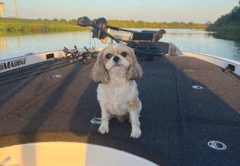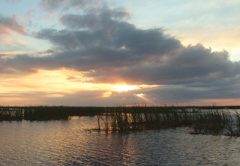In Florida we have many different species of fish we commonly refer to as panfish. In general terms, a panfish can be used to describe some small fish, whether freshwater or saltwater that does not outgrow the size of your typical frying pan. This month we look at the Warmouth, a freshwater panfish within the Sunfish family that is found throughout the State of Florida.
At a quick glance a Warmouth closely resembles a mix between a bass and a bluegill or Redear Sunfish. It has a stout deep body with a bass-like mouth. The jaw is lined with small fine teeth and it has a tongue-like structure similar to a bass. It has enlarged red eyes and has three or four stripes radiating back from the eyes across the cheek and gill cover as if they were war paint markings. The color of a Warmouth will depend greatly on its environment. They can have a brassy tone to a dark olive hue with hints of purple.
Within the eastern United States the Warmouth has a wide distribution range stretching as far north as central Minnesota through the Mississippi basin and into central Texas. In Florida they generally range in size up to 15 inches and weigh up to a pound. The State record is a 2.44-lb fish caught on the Yellow River in Okaloosa County by Tony Dempsey is October of 1985. They are an eligible species for the FWC Big Catch Angler Recognition Program with a minimum entry level for adult anglers of 9-inches or 0.5 lbs.
Warmouths are generally a solitary fish and inhabit sluggish water such as swamps, marshes, shallow lakes, slow moving streams and canals. They hang around aquatic vegetation, reed and cattail stands, stumps, logs, and underwater structures. The have a high tolerance for muddy or turbid waters, much more than other species in the Sunfish family. A female Warmouth will spawn over several months starting in April and continue into August. The female’s eggs will come into maturation over the entire spawning season so she will come onto a nest numerous times during the spawn. The male builds the nest and remains with the nest until the newly hatch larvae are free swimmers and can feed themselves which generally takes about 7 days to develop.
Warmouths are aggressive feeders and can be taken by many different means. Common natural baits include crayfish, insects, grass shrimp, night crawlers, red wrigglers, crickets, and meal worms. They also take small artificial lures such as beetlespins, inline spinners, small stick baits, poppers and other small topwater lures. If you are a fly fishermen just about any fly matching the hatch should work. Unlike specks, Warmouths are not nocturnal, they generally feed during the morning and become inactive (sleep) during the night. Being listed as a regulated sport fish by the FWC, the daily bag limit is set at 50 fish with no size limit. With those kind of numbers and the fact that their meat is pretty tasty, no wonder they are a favorite for the frying pan. Fishing for panfish is a great way to introduce the sport of fishing to a child. The startup costs are low, the action can be fast paced and the memories can last a lifetime. This summer make it a point to take a kid fishing.






